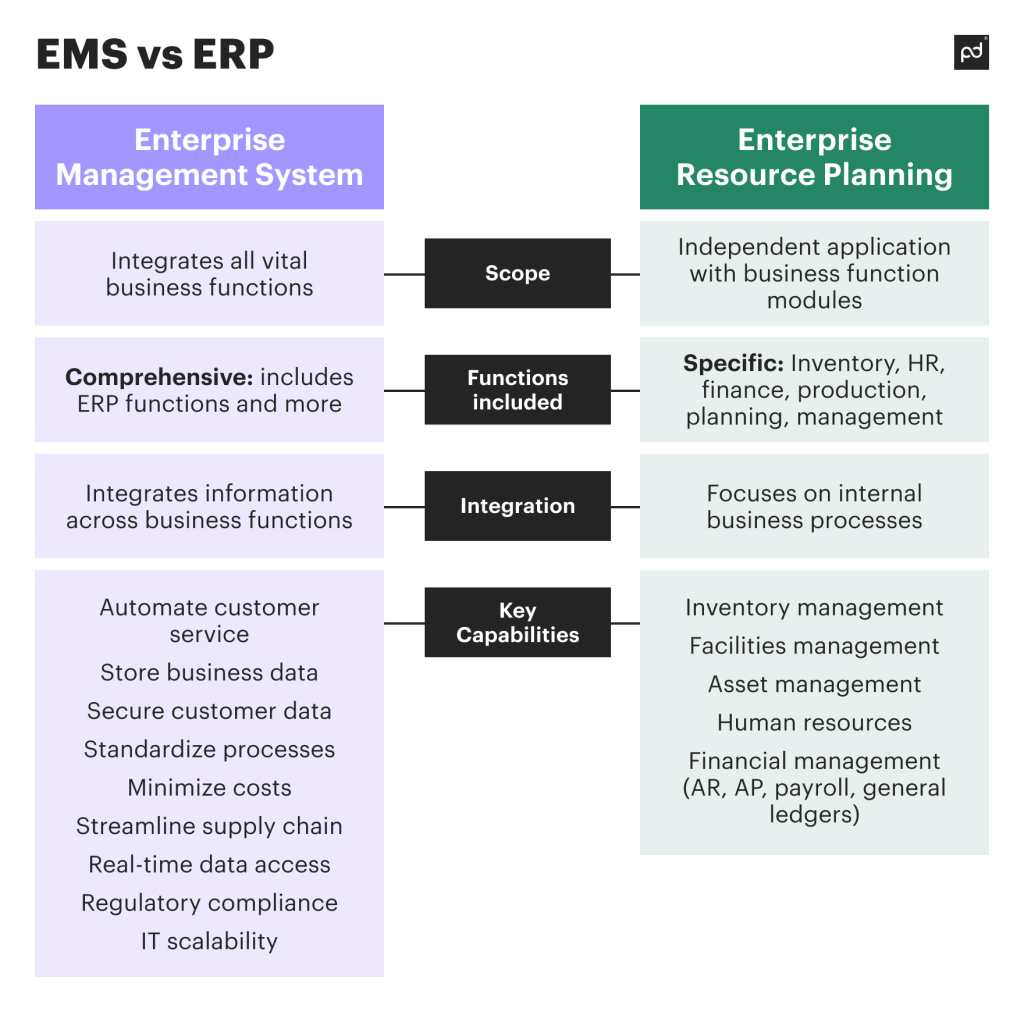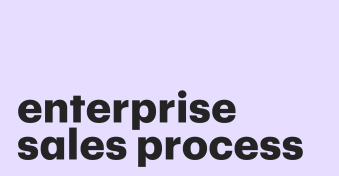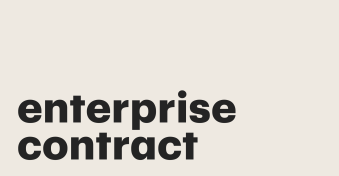Any enterprise with multiple teams and subdivisions working on different projects and initiatives needs a system to unify their efforts and improve process efficiency.
With enterprise management software, managers and executives can automate and optimize workflows across every aspect of the business.
In this article, we’ll discuss everything worth knowing about enterprise management software.
Key takeaways
- Enterprise management software (EMS) solutions help businesses manage, automate, and optimize workflows and processes.
- Corporations and massive business institutions can use EMS platforms to monitor and direct assets, content, documents, customer relationships, supply chains, and human resources.
- To make sure an enterprise management solution fits perfectly into your organization’s needs, provide ample support to train your teams and carry every stakeholder along.
What is enterprise management software?
Enterprise management software is a solution that helps enterprises and large corporations streamline, automate, manage, and monitor internal and external processes.
Whether in healthcare or manufacturing, the primary function of an EMS solution is to consolidate all SaaS apps, cloud services, databases, workflows, and projects under a single source of truth.
This makes it easy for managers to monitor projects, as well as usher in digital transformation for enterprises.
Types of enterprise management software
Enterprise management software can take different forms depending on the role it performs.
Enterprise resource planning (ERP)
For automating, centralizing, and managing business processes and workflows across departments and supply chains.
Enterprise asset management (EAM)
For managing the acquisition, disposal, and allocation of all physical assets owned or operated by the enterprise.
Customer relationship management (CRM)
For managing customer accounts through constant interaction and drawing insights from feedback. It also focuses on customer support and seamless service delivery.
Business intelligence (BI)
For integrating data from all sources in order to synthesize business insights for transparent and accurate reporting.
Content management system (CMS)
For gathering and storing ideas, creatives, and written content stamped for distribution and promotion,
Document management system (DMS)
For handling all files, contracts, certifications, licenses, permits, proposals, etc.,
Supply chain management (SCM)
For coordinating the inventory, restocking, purchase, and delivery of goods and business assets,
Human resource management (HRM)
For handling recruitment, training, payroll, complaints, conflicts, and other HR responsibilities.
Although these EMS types focus on specific business core functions, there is considerable overlap in capabilities, and multifaceted solutions exist that cover many of these aspects under one unified ecosystem.
Challenges to implementing enterprise management software
EMS systems are not plug-and-play. They require careful planning and resource allocation to avoid turning into an administrative disaster.
Here are some challenges you will likely encounter:
- Legacy systems are difficult to integrate with modern EMS solutions due to a lack of compatibility.
- Users might prefer using their old system because the new solution has a steep learning curve or because decoupling could lead to massive disruptions.
- Teams and departments may not be equipped to train and onboard new employees to use the solution.
- The cost of buying a fully-fledged EMS could outweigh the gains — some EMS vendors charge per user or per instance, which stacks up the pricing for large-scale companies.
- Keeping sensitive data secure can be challenging when multiple people have access to the solution. This creates several security loopholes for cyber attacks and malware injection.
You cannot guarantee the continuous availability of the solution to different users when they don’t have internet access.
The platform could lack in-depth payment and analytical tools, which means you need to pay extra for these applications.
Gains like automating workflows and reducing manual tasks depend on the capabilities of the EMS, integration ease, and user adoption; neglecting these aspects can cause inefficiencies and gaps in productivity.
Differences between EMS and ERP solutions
Enterprise management systems and enterprise resource planning solutions have interconnecting applications. Both systems can be used to manage business functions.
However, the key difference is that ERP solutions only cater to the management of business functions as well as physical resources (inventory, raw materials, equipment, etc.).

Conversely, enterprise management tools cover every aspect of the enterprise’s workflows, business processes, and assets. So, ERP is only a subset of EMS.
Benefits of enterprise management software
As the glue that holds all business processes together, here are the main benefits of enterprise management systems:
EMS solutions allow businesses and institutions to expand or shrink operations according to need and demand. For example, the Concord School District of New Hampshire used PandaDoc to transition over 5,000 students to a remote environment.
Enterprises can use these solutions to improve operational efficiency and productivity.
Logistics and eCommerce company ShipNetwork used enterprise management software to streamline inefficiencies for its entire workforce.
These platforms can improve the sales pipeline by helping enterprises acquire leads, monitor trends, create initiatives, and track campaign success. This helped Autodesk improve and track sales effectiveness through Salesforce API sync.
Using EMS solutions gives enterprises access to massive swathes of data for better decision-making, budgeting, and forecasting.
It can also break down information silos that tend to form in large enterprises.
Enterprise software improves employee and customer satisfaction by addressing their pain points and reducing manual workloads.
Companies that use EMS platforms for internal and external projects establish a collaborative environment founded on principles of transparency and accountability.
Automated enterprise management platforms use audit trails, notifications, and automated approvals to track user activity and reduce the time spent creating, signing, and exchanging documents.
EMS software provides a secure repository of templates for drafting and storing sensitive business documents for easy retrieval.
How to improve efficiency with enterprise management software
To guarantee that your organization’s EMS solution delivers on its promise and paves a path for seamless digital transformation, here are some best practices to follow.
Involve every stakeholder
Before choosing an EMS solution for large organizations, consider the opinions of every team member and C-suite executive.
The execs need to approve the budget for the solution your employees will use for IT service and daily operations.
Choose the right software
Part of the reason for involving every stakeholder is to ensure the EMS solution ticks every box: asset management, document handling, resource planning, business intelligence, etc.
Optimize the document repository
Choose a cloud-based solution that allows users to store essential files, modules, templates, licenses, SOPs, and invoices in the document repository.
Establish a consistent naming convention to improve discoverability.
Track performance metrics
Use analytical tools to track KPIs such as system downtime, uptime, sales life cycle, reliability, customer satisfaction score, conversion rate, etc.
Don’t overlook legacy applications
Consider modernizing legacy systems to add them to the ecosystem.
If modernization is too expensive, use integration solutions to connect the legacy application to the central IT infrastructure.
Prevent vendor lock-in
To avoid long-term vendor lock-in, keep your processes loosely coupled with the EMS solution.
If the system breaks down, you can decouple without disrupting regular business programming.
Train your staff
Conduct workshops and seminars to teach your employees how to use the EMS solution for procurement, onboarding, and other daily operations.
Prioritize security
Add firewalls, encryption, and authorization protocols as extra layers of security. Establish user roles and permissions based on authorization levels.
Increase productivity with enterprise management software
Large businesses and corporations can use EMS solutions to manage business processes in order to decrease costs, streamline collaborations, reduce workloads, and increase efficiency.
However, with multiple teams and users gaining access to the system, security becomes a pressing issue. You also have to grapple with legacy enterprise applications within the ecosystem.
The right project management software provides enterprises with a solution for managing documents, assets, business data, and HR.
Ready to test drive using PandaDoc for enterprise management? Book a quick demo and learn more about the platform’s capabilities.
Disclaimer
PandaDoc is not a law firm, or a substitute for an attorney or law firm. This page is not intended to and does not provide legal advice. Should you have legal questions on the validity of e-signatures or digital signatures and the enforceability thereof, please consult with an attorney or law firm. Use of PandaDoc services are governed by our Terms of Use and Privacy Policy.


